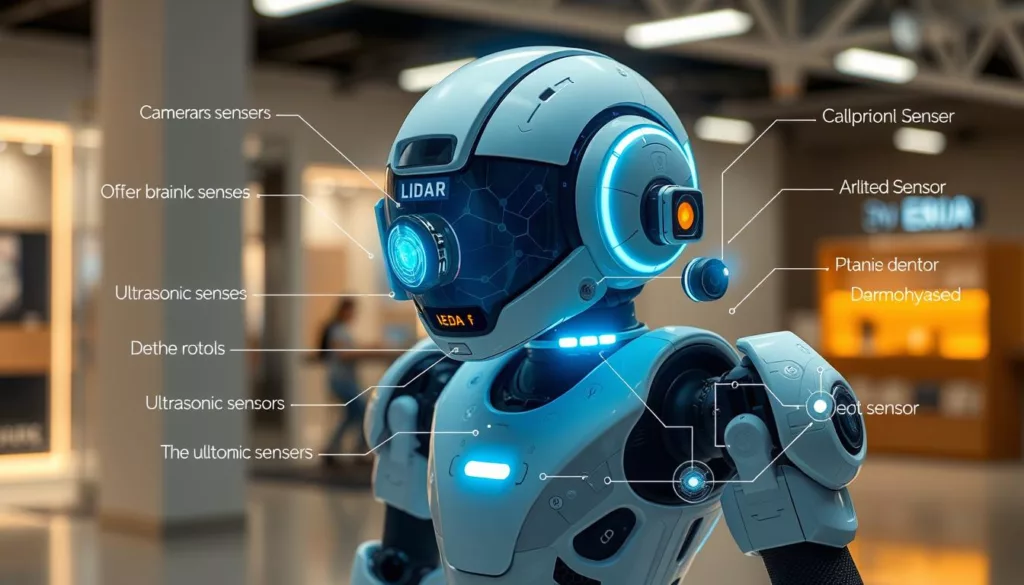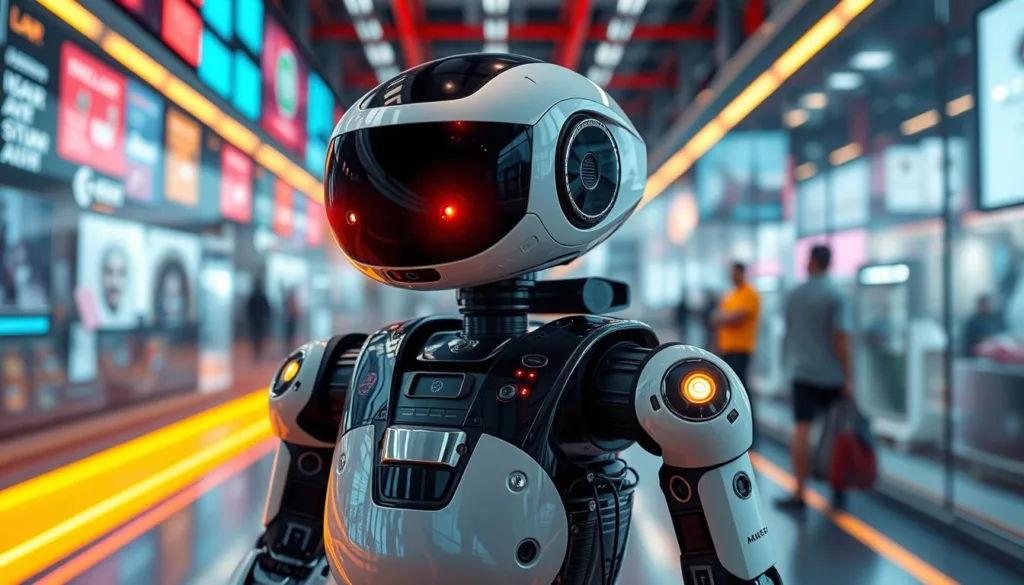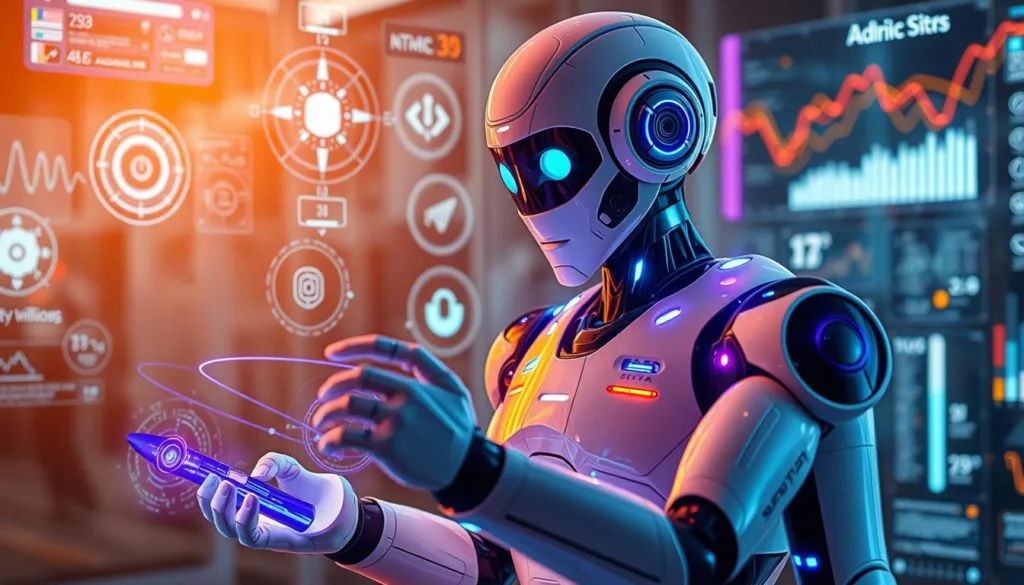In the fast-changing world of service robotics, customizable sensors are making a big difference. These advanced sensors help service robots understand and interact with their surroundings better. This makes them more efficient, safe, and useful in many areas.
These sensors are designed to fit the needs of each task. They can do things like detect objects close by, check temperatures, and even see and analyze the environment. This makes service robots do more than ever before.
Key Takeaways
- Customizable sensors enable service robots to adapt to specific tasks and environments
- Enhanced performance and precision through tailored sensor integration
- Increased versatility across diverse service robot applications
- Seamless integration with robotic control systems and software
- Cost-effective solutions for optimizing sensor capabilities
Introduction to Customizable Sensors for Service Robots
In the world of service robotics, customizable sensors are changing how these smart machines see and interact with their world. These advanced sensors help service robots do many tasks better, faster, and more flexibly.
The core idea here is sensor fusion. It combines different sensors to give a full picture of what’s around a robot. This is key for tasks like mapping environments and working with humans, making service robots more capable.
“Customizable sensors are the key to unlocking the full sensor fusion of service robots, allowing them to adapt to the unique demands of each application with precision and agility.”
Service robots use various sensors, like proximity and thermal imaging, to move through complex spaces. They can spot dangers and meet human needs with great skill. This adaptability is vital in many fields, from healthcare to manufacturing.
The role of customizable sensors in service robotics will keep growing. They help create strong sensor fusion and environmental mapping abilities. These technologies are set to lead the next big steps in service robot design, changing how we use these smart machines.
Benefits of Using Customizable Sensors
Customizable sensors bring many benefits to service robots. They improve the robots’ performance and open up new uses. These sensors help robots move around easily and safely, thanks to better obstacle avoidance, autonomous navigation, and sensor optimization.
Enhanced Performance and Precision
Service robots get a big boost from customizable sensors. These sensors help robots collect more precise data. This leads to smarter decisions and more efficient work.
Robots can avoid obstacles better and navigate on their own more smoothly. This makes them safer and more reliable in tricky places.
Increased Versatility Across Applications
Customizable sensors make service robots more flexible. They can be adjusted for different industries, like healthcare, hospitality, manufacturing, and logistics. This sensor optimization lets robots handle more tasks and work in many places.
“Customizable sensors are transforming the capabilities of service robots, empowering them to tackle complex challenges with unparalleled precision and adaptability.”
With customizable sensors, service robots can move around obstacles more easily. They can also improve their autonomous navigation and adjust to new situations. This makes them very useful in many areas.
Types of Sensors Available for Service Robots
Service robots use many sensors to understand their world. These sensors help them see, map, and talk to humans. They make sure the robots can move, watch, and act on their own.
Proximity Sensors
Proximity sensors help robots find objects close by. They use infrared, ultrasonic, or laser to know how far away things are. This helps the robot avoid hitting things or picking up objects.
Temperature Sensors
Temperature sensors are key for robots in different places. They check the temperature around the robot. This helps the robot stay safe and comfortable, which is very important in places like hospitals and hotels.
Vision Sensors
Vision sensors, like cameras, are very important for robots. They take pictures of what’s around the robot. Then, the robot can understand what it sees, like faces or gestures. This makes it easier for humans and robots to work together.
Environmental Sensors
Environmental sensors check things like air quality and light. They help the robot know what’s going on around it. For example, air sensors can find bad smells or pollutants. This lets the robot know it needs to do something or tell a human.
With all these sensors, service robots can move around, see what’s happening, and talk to humans better. This makes things easier and more efficient for everyone.
Key Features of Customizable Sensors
As service robots evolve, the need for customizable sensors grows. These sensors bring important features that boost a robot’s performance and flexibility. They make robots more versatile and effective.
Flexibility and Scalability
Customizable sensors are very flexible. They fit well with different robot designs and tasks. This makes them easy to use and adjust as needed.
They also grow with the robot. Designers can add more sensors as tasks get harder. This way, robots can handle more complex jobs without big changes.
Integration Compatibility
These sensors work well with other robot systems. They fit into many service robot design and sensor integration setups. This makes adding new sensors easy.
This is great for developers. It lets them use the latest sensors without big changes. It makes building robots faster and better.
“The flexibility and integration capabilities of customizable sensors are essential in unlocking the full sensor optimization of service robots. They adapt to different environments and user needs.”
Using customizable sensors helps make robots more adaptable and useful. This approach keeps robots at the tech forefront. It gives them better performance and solutions for users.
Applications of Customizable Sensors
In robotics, customizable sensors are used in many fields. They help in healthcare, hospitality, and industrial automation. These sensors let service robots move on their own, talk to humans, and do tasks better.
Healthcare and Assistive Robots
In healthcare, these sensors change how assistive robots work. They have sensors for distance, temperature, and vision. This lets them watch over patients, manage medicine, and help with rehab.
These robots can adjust to what each patient needs. This makes care better and helps patients get better faster.
Hospitality Industry Robots
The hospitality world also uses these sensors in robots. Robots can deliver room service, help guests, and keep hotels clean. They use sensors to move around, understand what guests want, and work better.
This makes guests happier and helps hotels run smoother.
Industrial Automation Solutions
In industrial automation, sensors help a lot. Robots with different sensors can move around factories, watch over production, and handle materials. This makes factories work better, with fewer mistakes and more done.
These sensors help robots work on their own, talk to people, and meet each industry’s needs. This leads to better work, more done, and happier customers.
Selection Criteria for Customizable Sensors
Choosing the right customizable sensors for service robots is key. We need to look at several important factors. These help make sure the sensors we pick are perfect for the robot’s job and work well.
Performance Metrics
First, we check the sensor’s performance. This includes how accurate, detailed, and fast it is. It also matters how sensitive it is. These specs must match what the robot needs to do and where it will work.
Looking closely at what the sensor can do is vital. This ensures it meets the customizable sensors for service robots standards.
Adaptability to Specific Tasks
Next, we think about how well the sensor fits the robot’s tasks. It should work well and reliably, no matter the task. This could be spotting obstacles, checking the environment, or taking pictures.
Being flexible and able to adapt is important. This makes sure the sensor is the best choice for the job.
Cost Considerations
Lastly, we consider the cost of the sensor. It should offer good value for its performance and features. We also think about the long-term costs, like upkeep and replacement.
By carefully looking at these factors, we can pick the best sensor optimization solutions. This improves the robotic perception and performance of our customizable sensors for service robots.
Challenges in Implementing Customizable Sensors
Adding customizable sensors to service robots can face technical and cost hurdles. These sensors boost performance and flexibility. Yet, to get past these hurdles, careful planning and investment are needed.
Technical Limitations
One big challenge is the technical side of adding these sensors. Making sure they work well with the robot’s system and software is hard. It needs special skills and lots of testing.
Also, fitting different sensors together can be tricky. It affects how the robot avoids obstacles and works as a whole.
Cost and Budget Constraints
Costs can also hold back the use of customizable sensors in robots. The benefits are clear, but the initial cost is high. This includes the price of sensors, integration, and upkeep.
It’s important to weigh costs against benefits. And to plan the budget carefully. This ensures the sensors are worth it in the long run.
| Technical Limitations | Cost and Budget Constraints |
|---|---|
|
|
“Overcoming the challenges in implementing customizable sensors requires a delicate balance of technical innovation and strategic financial planning.”
By tackling these challenges head-on, robot designers can make customizable sensors work. This unlocks the full power of these cutting-edge technologies.
Future Trends in Sensor Technology for Service Robots
The world of service robotics is changing fast. New sensor technologies are on the horizon. They will make robots work better and smarter. Advances in artificial intelligence (AI) and machine learning, and the rise of the Internet of Things (IoT), are leading the way.
Advancements in AI and Machine Learning
AI and machine learning are moving quickly. They help service robots understand sensor data better and faster. Sensor fusion is getting better, allowing robots to make smarter choices and move around more easily.
This is key for robots working in busy places like hospitals and factories. They can handle complex tasks with more confidence.
Increased Adoption of IoT in Robotics
IoT is changing how robots talk to their environment and people. By linking sensors and robots to the internet, they get access to lots of data. This lets them work better and team up with humans more smoothly.
These tech leaps mean service robots will soon be more flexible, accurate, and connected. They will be more reliable in many areas, making our lives easier.
Conclusion: The Importance of Customizable Sensors for Service Robots
Customizable sensors are key to making service robots better. They make robots more efficient, versatile, and smart. As these sensors get better, they will lead to new ways to automate many industries.
Healthcare, hospitality, and industrial automation will all benefit. Customizable sensors for service robots are changing robotics. They improve robotic perception and enhance sensor optimization.
These sensors boost performance, precision, and versatility in service robots. They make robots fit any task or environment. This is important as more people want smart, adaptable automation.
The future of service robots will be shaped by advanced sensors, AI, and the Internet of Things. Investing in sensors for service robots helps companies stay ahead. It drives innovation in their fields.






